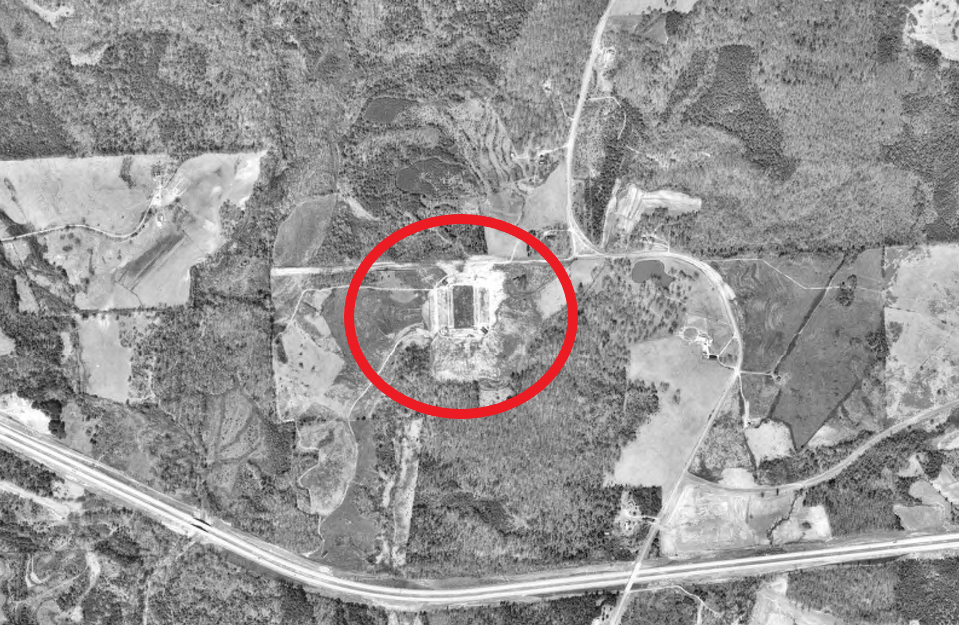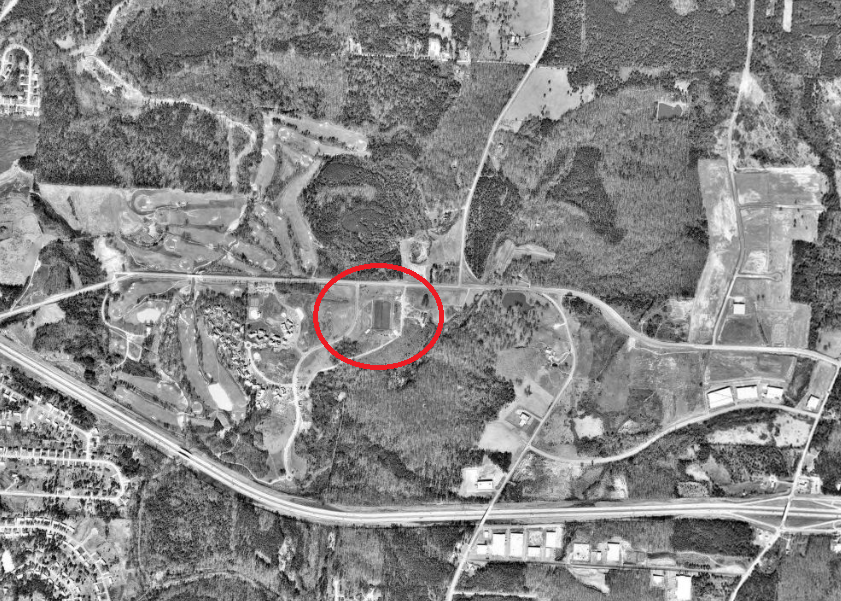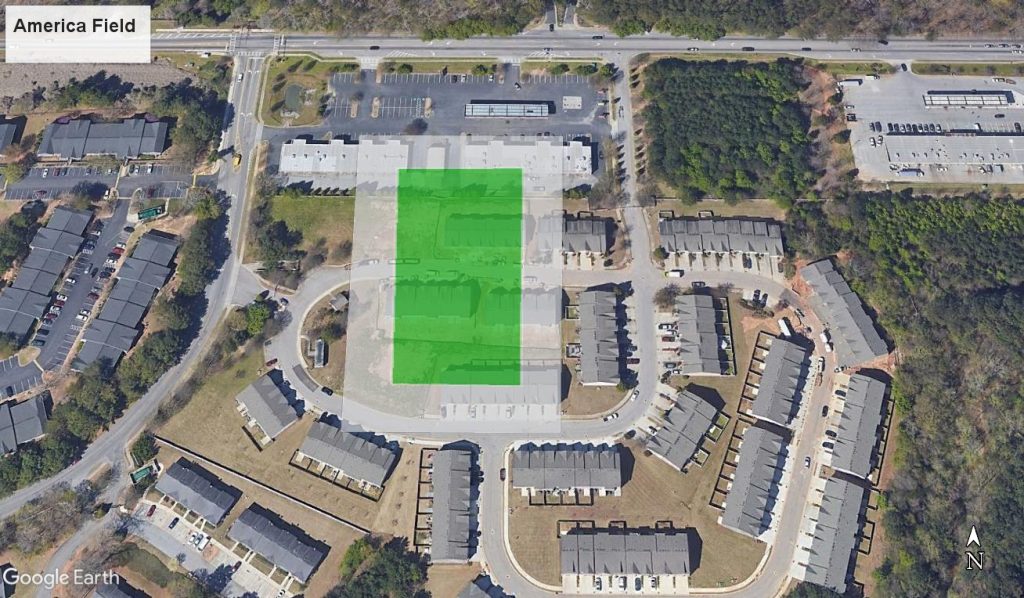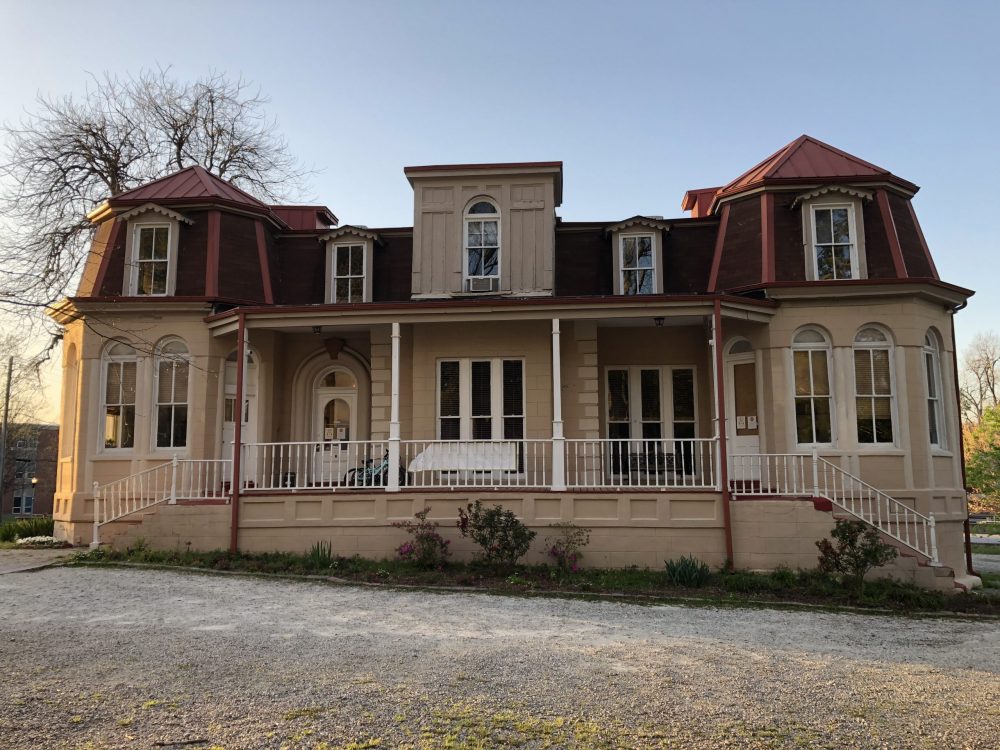America Field, the AFL’s Touchdown in DeKalb
In 1962, America Field was built in rural DeKalb County. The American Football League hosted two exhibition games there. This is the story.
_______________________________________________
By Marissa Howard, Programs and Membership Coordinator
In a quiet suburban DeKalb neighborhood off of Snapfinger Woods Dr not much remains of Bill McCane’s dream. On a balmy August night in 1962, the American Football League’s (AFL) Dallas Texans and the Oakland Raiders played an exhibition game on an old chicken farm. The attendance was meager, the facilities were lacking, but Bill McCane was optimistic. “ . . . I promise you, the best lies ahead.” (The Atlanta Constitution, Aug. 6, 1962.)
Bill McCane, a DeKalb businessman, had a dream of bringing the AFL to Atlanta and DeKalb County. Tired of red tape and bureaucracy, McCane decided to do it himself.
Not much is known about William V. McCane, Jr., before 1962. As a salesman (no specific company was ever listed), originally from Augusta, he lived a modest life in DeKalb County. He first appeared in a newspaper in 1957, as spokesperson for the Youth Recreation Centers of DeKalb. He was attempting to raise funds to build recreation centers across DeKalb. In 1960 he was a spokesperson for the Southern Professional Football league, home of the Atlanta Rebels where he hoped to build a “six million dollar stadium” somewhere around Atlanta in the next three years. (The Atlanta Constitution, Dec. 23, 1960.)
Up until the 1960s, Atlanta did not have a major professional sports team or a major municipal sports stadium. Smaller stadiums across the metro area were used, but if Atlanta wanted a professional team a larger one would have to be built. Stadiums, which were often funded by bonds and the government, were built as a tool to entice new teams. The “if you build it, they will come” model.
An earlier proposal was pushed by Scott Candler, Sr., DeKalb County Commissioner, in 1942 for a DeKalb Memorial Park off of Memorial Drive.
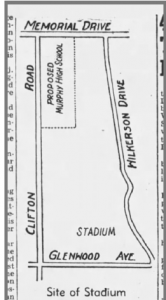
Proposed stadium by Scott Candler in 1946. Site is now home to DeKalb Memorial Park. The Atlanta Constitution, Aug. 19, 1946.
“Soldier Field,” as it would have been called, would have been the “. . . south’s largest and most modern athletic stadium.” This proposal ultimately failed before the Atlanta City Council in 1946. In fact, it was widely known that building a large multipurpose stadium had been a “continuous failure since 1920 . . . Without exception, each movement has wavered for lack of proper organization, study or other reasons, finally dying out altogether.” (The Atlanta Constitution, July 20, 1962, originally printed in 1947) DeKalb County and the City of Atlanta would continue to engage in a back and forth gridlock for the next decade on the subject of a municipal stadium: who would pay for it and where would it be located? In a sly foreshadowing, Cobb County asked the Georgia Assembly for the power to erect a municipal stadium of their own, in the vicinity of present day Truist Park.
By the early 1960s, Atlanta was still at the top of the list for prospective major league teams and yet without a stadium. Frustrated sports writer and columnist Jesse Outlar described Atlanta as the “Sahara” and 25 years behind Birmingham and Mexico City who boasted their own major municipally funded stadiums.
As far as professional football, the AFL and NFL were in a fierce battle to move into the Atlanta market. McCane was courting them both. The NFL would not have a team available to relocate until 1962, but the AFL was newly formed and eager to expand by 1961. However, neither league had a stadium for a team to move into. In April 1961, an announcement was made by Bill McCane and his new organization, the Greater Atlanta Athletic Association, Inc.

The Tennessean Newspaper, April 2, 1962.
McCane promised “105,000 seats and at least 50,000 seats ready by the start of the 1962 football season . . . and we hope to have the whole thing finished and be ready for major league baseball by 1963.” (The Tennessean Newspaper, April 2, 1961.)
The location would be in southwest DeKalb about 15 miles from downtown Atlanta on land donated by a chicken farmer.
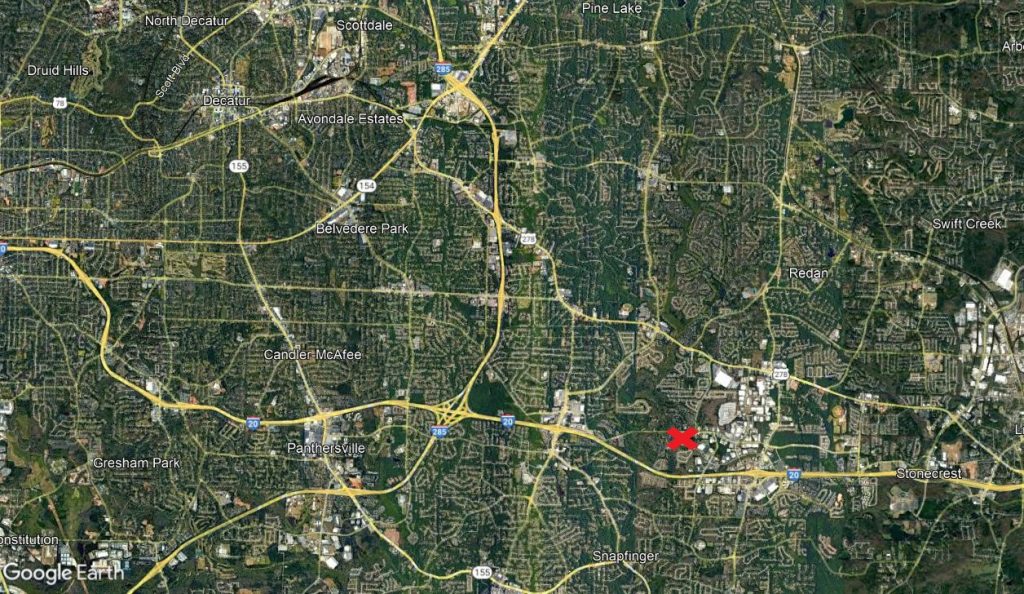
X marks the spot of America Field.
First, a temporary stadium would be built, and later after a franchise was secured, the permanent stadium would be built on the same site. However, the infrastructure would be up to DeKalb County. The sewer alone was estimated to cost $1,000,000.
Bud Adams, an oil tycoon, founder of the Houston Oilers, and AFL founder, was McCane’s biggest supporter. He was there alongside McCane at the groundbreaking in January 1962. Adams made a few conditions clear to the press if he wanted to bring an AFL team to Atlanta. 1. How Atlanta would fare hosting exhibition games. 2. How the ticket sales went.
He also made it clear he was not financially supporting America Field and would just bring in 12,500 temporary seats. But who was paying for the stadium?
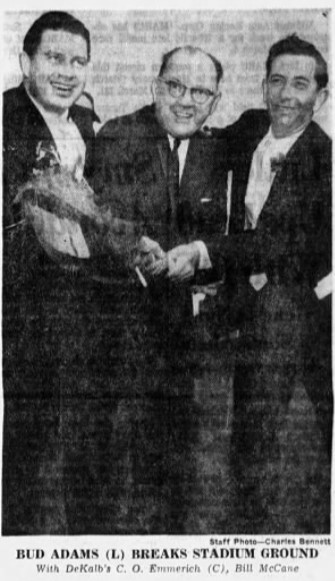
The Atlanta Constitution, January 27, 1962.
McCane had lured AFL teams to sign on for four exhibition games. The opener would be Dallas Texans vs. Oakland Raiders on August 4th.
Concurrently, the NFL was scouting locations for their own exhibition game and was temporarily using Grady Stadium. The NFL would host their own exhibition game that same weekend.
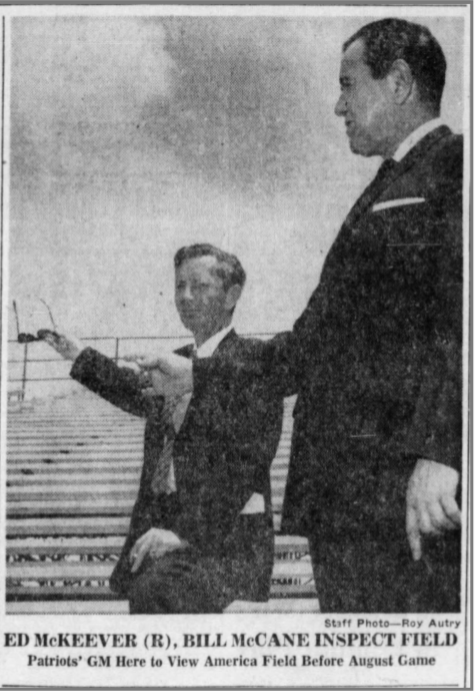
The Atlanta Constitution, June 19, 1962.
By June 1962, two months before opening night, McCane’s dreams were set back with the AFL voting against expansion. The exhibition games would continue with advertisements for tickets across the newspapers counting down till opening night.

The Atlanta Constitution, June 9, 1962.
“McCane deserves an applause for one thing in particular. He’s the only person in Greater Atlanta who as so much as dug a stadium hole. As late as Friday afternoon, other citizens have done nothing more than talk” -Jesse Outlar, The Atlanta Constitution, May 12, 1962.
Local press reporters were amazed McCane did more on his own in six months than the City of Atlanta and DeKalb County could do in decades. But they were still skeptical and “waiting for the concrete to be poured.”
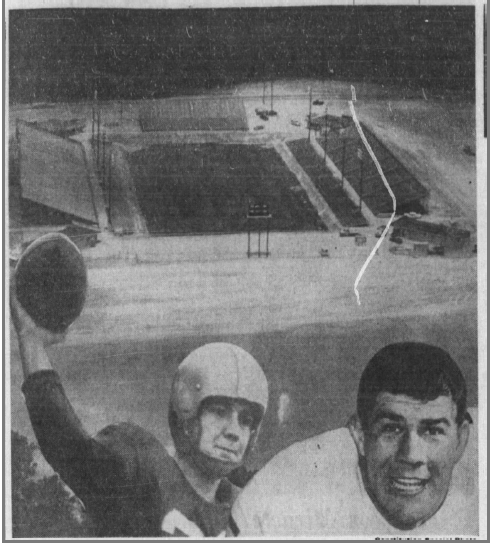
Image of America Field stadium and grounds. AFL stars E. J Holub (R) of Dallas and Don Heinrich of Oakland. The Atlanta Constitution, August 4, 1962.
On Saturday August 4, 1962 – Kickoff. There was dust on the field, the scoreboard clock did not work properly, and a bus drove over and busted the water line: the players couldn’t shower after the game. The crowd was not what McCane expected, but he was still optimistic. The half time show featured an appearance by Miss America Field, Carol Porter, music by the Monroe Girls Drum and Bugle Corps, and a performance by Twirling Champion Buddy Clark.
By Monday, August 13th, the Boston Patriots and New York Titans had pulled out of the scheduled exhibition game.
“Well, That’s It” – Bill McCane, Aug 13, 1962
Questions about money began instantly, and by August 21st the Greater Atlanta Athletic Association was put into receivership for lack of payments to over a 100 creditors. By October the Greater Atlanta Athletic Association failed to pay the $300,000 it owed in back payment.
It was uncertain whether the 350 stockholders would receive anything in return.
On a blistering cold February day in 1963, the items of America Field were auctioned off one by one. The bleachers, refreshments, unused lumber, lockers, furniture, lights, and the field itself. That was that, the dream of America Field was over.

The Atlanta Constitution, Feb 16, 1963.
So, what actually happened? If there was a choice in 1962 to watch any two football teams play, the Oakland Raiders and Dallas Texans were not on that list. They both had trouble getting fans to go to their own home games. Atlanta had no reason to get excited.
The location of America Field was also a tough sell. It was in the middle of nowhere, with limited infrastructure. Busses and fans were continually getting lost. There was no ramp access from I-20, despite advertisements claiming “right off of the expressway”. Tickets were also slightly more expensive than normal, so the first game only brought in around 6,000 fans. The second game had better attendance, but it was certainly not at capacity.
The American Football League did not support McCane financially, which he needed. The AFL pulled away just as fast, including the 12,000 seats Bud Adams brought to the opener. Reflecting on America Field, reporter Jesse Outlar remarked, “The AFL helped McCane carry the ball to midfield, then dropped it.”
“We came a lot closer to pulling it off . . . ” – Bill McCane, 1972
A decade later, a reporter caught up with McCane at his 100 acre property in Loganville.
“I came to Atlanta in the 1940’s and I just got tired of hearing politicians double-talking about building a stadium here. I found out they’d been talking about it since 1910. So I thought I’d do it myself and bring the AFL here.” (The Atlanta Constitution, April 17, 1972.)
Atlanta finally secured pro teams in 1965 with the Atlanta Braves and Atlanta Falcons, and the Atlanta-Fulton County stadium was built in a year and lasted for 32 years before being demolished.
Turns out all stadiums are temporary.
- America Field, 1966. Three years after the auction, remnants of the field can still be seen. Notice the lack of roads to the site. Source: United States. Agricultural Stabilization and Conservation Service. Aerial Photography Division (1960). Dekalb County, 1960: Aerial photography index. Retrieved from https://dlg.usg.edu/record/gyca_gaphind_dekalb-1960#item
- Remnants of America Field, 1972. Source: United States. Agricultural Stabilization and Conservation Service. Aerial Photography Division (1972). Dekalb County, 1972: Aerial photography index. Retrieved from https://dlg.usg.edu/record/gyca_gaphind_dekalb-1972#item
- Present day location with America Field overlay. Area in green is field, area in white is stands. Source: Google Earth, projections based on historical aerial imagry.
Additional Information:
Pro Football Comes to Dekalb County – America Field, Atlanta & the AFL in 1962


